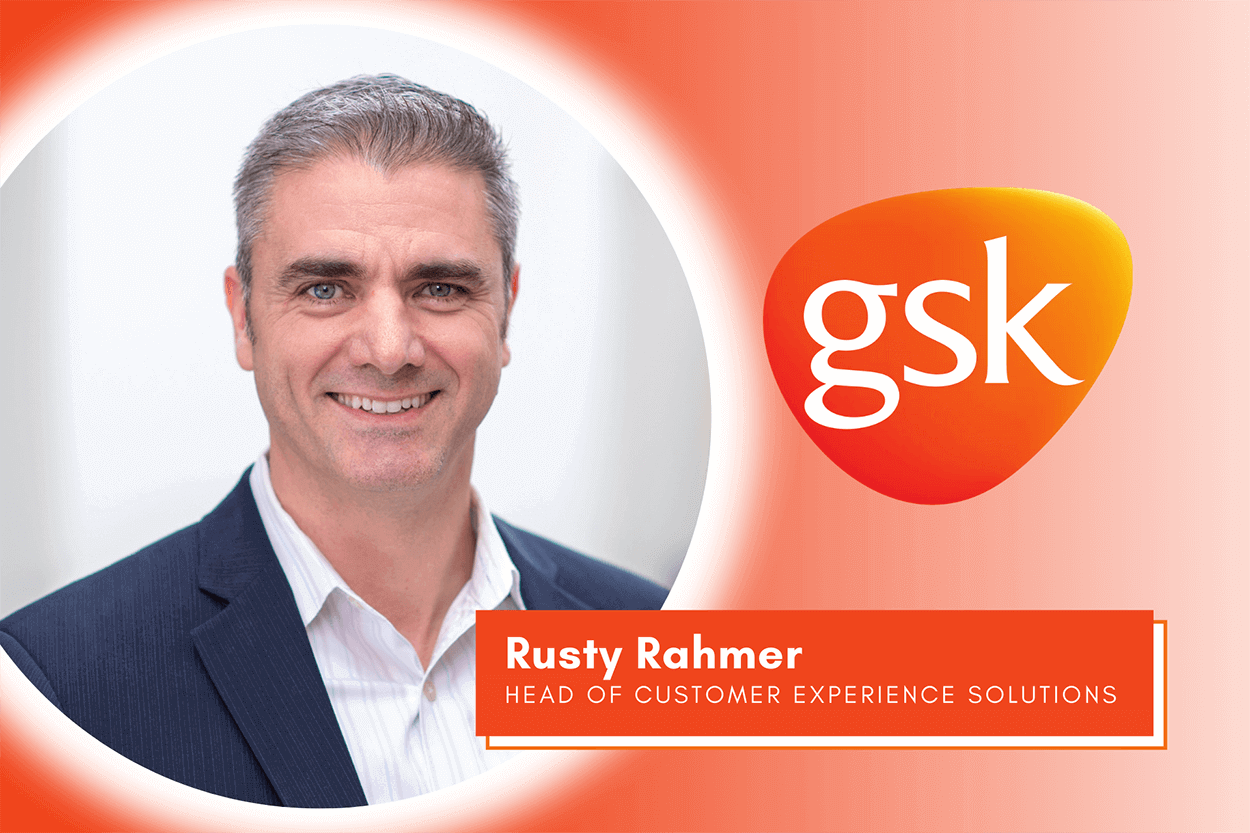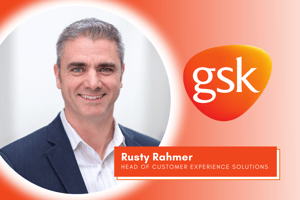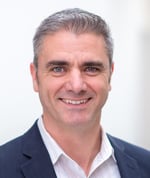
What can the pharma industry learn from financial services--particularly in regard to customer experience (CX)? There’s no better person to ask than Rusty Rahmer, Head of Customer Experience Solutions at GSK. Rusty recently shared how his vast experience at an investment management firm has translated to his current work in the pharma universe.
Specifically, we discussed three financial services characteristics that are valuable in the pharma space, why first-party data will be critical in the forthcoming “cookieless world,” and GSK’s strategy for unifying the efforts of 20+ brands.
The full text of our conversation is below.
Edith Hodkinson: You joined GSK as Head of Customer Experience Solutions in 2019, following many years at an investment management company. What drew you to pharma?
Rusty Rahmer: I was really attracted to the rapidly emerging technology, data, and patient care trends in healthcare. Even as an outsider to the industry, I could see the challenge of supporting healthcare professionals and patients through all the incredible progress that was happening and get really excited about developing innovative data-driven solutions to these challenges. It wasn’t hard to see the real tangible impact the work could have in improving the lives of patients and their families, and I wanted to be a part of that.
EH: What areas of digital marketing do you see as offering the most opportunities for pharma brands?
RR: I believe digital marketing can help brands cut through the noise and support patients and doctors in ways never possible, with timeliness and relevance that meets them when and where they are in their time of need.
EH: Coming from a highly regarded financial services company known for its quality CX, what can pharma brands learn from marketers in the financial services industry?
RR: I think there are three key things that are extremely valuable to pharma...
First, when you win a customer in the financial services industry, you tend to win them for life--unless you fail to provide quality service at the key moments; typically life events. So, financial services companies are finely tuned to customer experiences, detecting these moments of truth in the customer lifecycle, anticipating the customer’s need, and delivering amazing value-added experiences that solidify the customer/brand relationship.
Second, the degree to which a financial services company thinks really omnichannel--from digital, to field sales, to phone center, to back-office paper/processing--the experience has the next contact with the customer in mind and a complete sharing of information and orchestration of communication/transparency throughout the company. At all times, they are prepared to meet the customer in any channel the client chooses to contact them in, with the latest information and experience goals.
Third, in financial services, talking about your products or their performance can be considered giving investment advice or not disclosing risks; content which is highly regulated. Like pharma, it’s extremely difficult for marketers to really get into things about their products with clients and prospects. So, long ago, financial service providers learned the power of promoting industry thought leadership and perspectives as a powerful tool to promote their brand. Customers and prospects tend to really align with the widely differing perspectives, and the products of each financial service company will reflect these core tenets or principles of their philosophies. To marketers in financial services, promoting industry-leading thought leadership is not just in support of their product lineup. To them, it is their product! I think a lot about that in the context of promotion of medical affairs--and content that is thought-leading about the landscape of care within a given therapeutic area and the opportunities that may exist for products to improve patient outcomes in support of the solutions and products that are developed from that kind of “above brand” thinking.
EH: Pharma manufacturers, such as GSK, often have 10, 20, or more brands under their management, with each often operating under unique circumstances and requirements--which is perhaps a change from your past organization. From a digital experience and strategy perspective, how do you unify the efforts of 20+ brands?
RR: It’s a great question. When you think about the customer journey and the challenges of creating awareness, education, support, and adherence in patients and doctors across your portfolio, it can be extremely nuanced to each product and/or therapeutic area.
If timeliness and relevance are your objectives, first-party data is, now more than ever, the gold standard of marketing.
And yet, there can also be commonality in certain experiences, like attending an event or ordering samples. Inherently, I think your strategy must seek a balance in solutions to addressing both the scalable and highly-customized experience scenarios. Our program strategy has focused on speed and agility from idea to delivery to drive experimentation and read/react approaches to addressing the highly customized brand experience scenarios. And, a more global approach to driving the above (or cross-brand) experience strategies with an eye on scalability.
EH: How do you evolve all brands within the organization when there may be varying levels of digital sophistication? And, how do key learnings play a part across all brands?
RR: A lot of our brands are focused on different aspects of digital, so they tend to become relatively progressive or “mature” in their sophistication in those areas before their peers. Collectively, as a CX organization, we work hard to share the work that is happening and the success/learnings/best practices/etc. that are being had across the brands and therapeutic areas. We do this through several different forums--targeting different audiences, from the executives of each brand to the day-to-day marketing resources. This helps us create a common working body of knowledge and success from which to pull and build on across the enterprise--that we can then leverage and share to help advance the total enterprise, without everyone having to follow the same exact path to sophistication or maturity. So far, it’s proven really successful as every brand has made contributions to progressing our enterprise!
EH: How important will first-party data be for pharma brands in the so-called “cookieless world”? How is GSK preparing for this potentially radical change?
RR: Critically important. If timeliness and relevance are your objectives, first-party data is, now more than ever, the gold standard of marketing--and the exchange of value is the primary currency to acquire more of it. To prepare for this, we’re taking a hard look at ways we can create more value to increase the amount of our first-party data, methods and capabilities for how we handle and keep the data fresh, partnerships with companies like DMD who can help us identify and build on first-party data, and making changes in our MarTech platforms to do business differently with our media and marketing partners (CDP, clean rooms, etc.).
EH: One of the initiatives you are leading at GSK is the implementation of an omnichannel next-best engagement engine to coordinate HCP engagement across brands and your field force. How do you integrate disparate data sets into a curated layer--a translated layer--that becomes useful and used by your field force?
RR: This is a great question! The data and tech are quite frankly the easy part. It’s filtering out the noise and getting meaningful insights and triggers into the hands of your skilled field force that is the tricky part here and can truly be an area of competitive advantage. I would also score this area of capability as extremely high in terms of requiring a high degree of innovation to solve. To me, innovation makes the speed and cycles of experimentation, discovery, and learning the key units of success. To be able to achieve that sort of speed of idea to learning, you’ve got to get lean, slice thin, and have rapid cycles of closed loop feedback on your models and the uptake/success of your field interactions. So, create a small team of the skills you need, including field reps, to collaborate on how to use demographic, attitudinal, observed, and behavioral as data triggers and models to deliver and evaluate the experiences and engagements in fast low-tech cycles and get instant feedback on how it’s working and what adjustments need to be made. The faster you can cycle through this, the faster you will achieve and keep competitive advantage in truly omnichannel next best engagements.
About Rusty Rahmer, Head of Customer Experience Solutions at GSK | Executive Board of Directors at Digital Analytics Association

Rusty Rahmer is the Head of GSK’s Customer Experience Solutions, leading the platforms, channels, and services for omnichannel marketing orchestration in the US. He is a member of the Executive Committee and Board of Directors of the Digital Analytics Association. He has over 15 years of experience in leading digital strategy, digital transformations, and building high impact omni-channel customer experience operations in the Financial Services and Pharmaceuticals industries and has been the keynote speaker and presenter at more than 20 industry leading conference events, including; Adobe Summit, eMetrics, Marketing Evolution, the DAA OneConference, Analytics Nexus, and Digital Analytics Hub.


